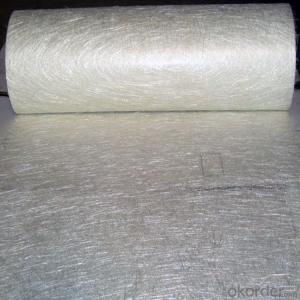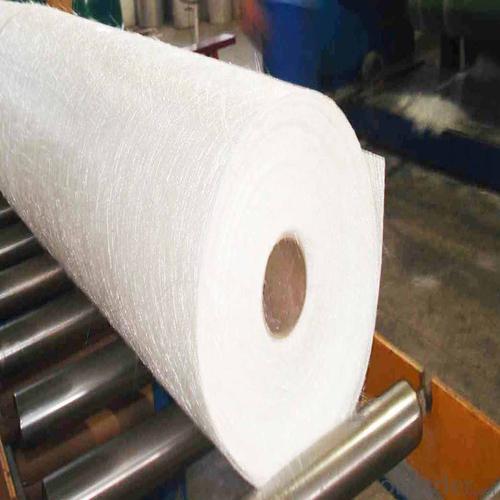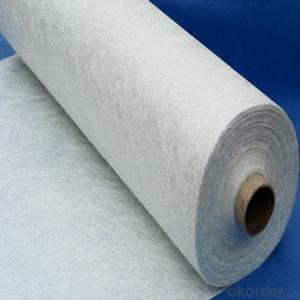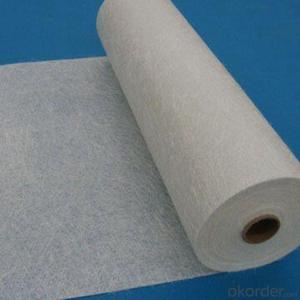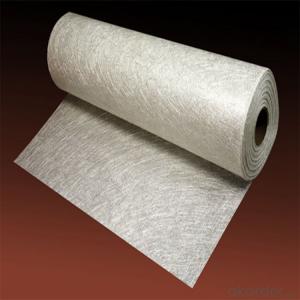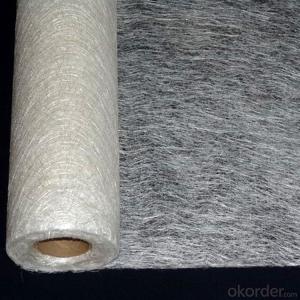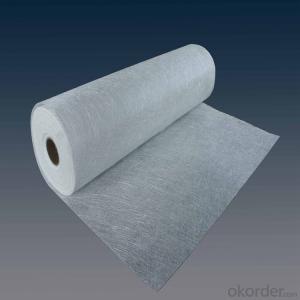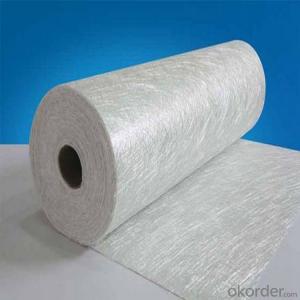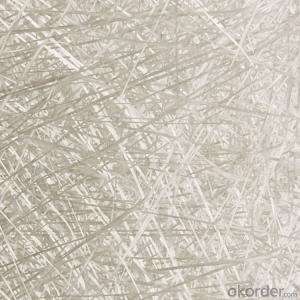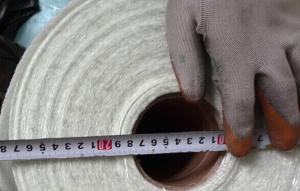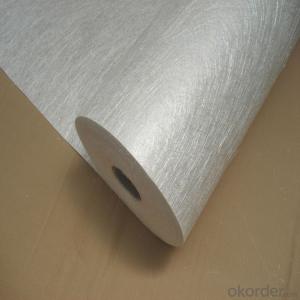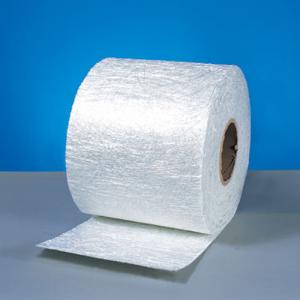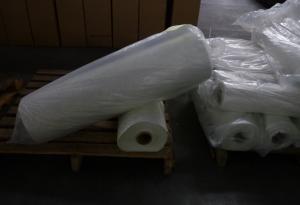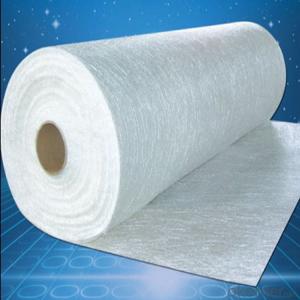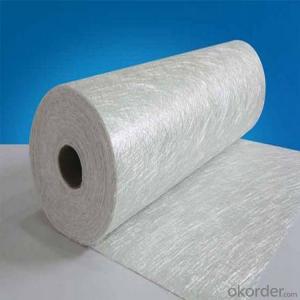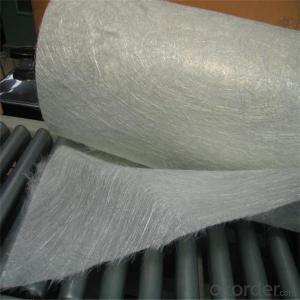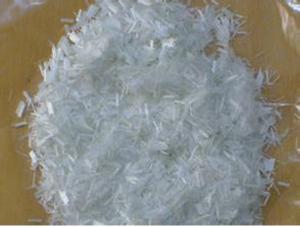Fiberglass Chopped Strand Mat Combination Mat Slide Mat
- Loading Port:
- China main port
- Payment Terms:
- TT OR LC
- Min Order Qty:
- 1 kg
- Supply Capability:
- 5000 kg/month
OKorder Service Pledge
OKorder Financial Service
You Might Also Like
Product Description:
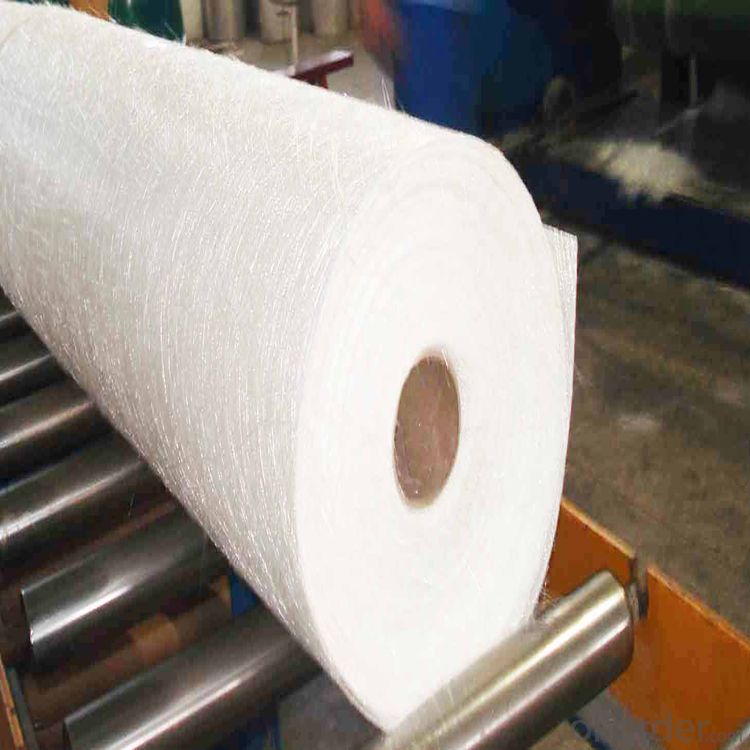
Surfacing Tissue mainly used in the surface layers of FRP products. It features even Fiber distribution, soft feel, level and smooth fiber surface, less glue content, quick resin soak and good pattern fitness. It can improve the product surface property on corrosion resistance, compressive strength, seepage resistance, and longer service life. It is also suitable for spraying; pattern pressing and other FRP pattern technology.
Surfacing Tissue mainly used in the surface layers of FRP products. It features even Fiber distribution, soft feel, level and smooth fiber surface, less glue content, quick resin soak and good pattern fitness. It can improve the product surface property on corrosion resistance, compressive strength, seepage resistance, and longer service life. It is also suitable for spraying; pattern pressing and other FRP pattern technology.
Product Features:
Fast breakdown in styrene
Fiber dispersed evenly
Low binder content
Superior acid corrosion resistance
Specifications:
Item | Over Density | Moisture Content | Chop Density | Polyester Yarn | Width |
(g/m2) | (%) | (g/m2) | (g/m2) | (mm) | |
EMK300 | 309.5 | ≤0.15 | 300 | 9.5 | 50-3300 |
EMK380 | 399 | 380 | 19 | ||
EMK450 | 459.5 | 450 | 9.5 | ||
EMK450 | 469 | 450 | 19 | ||
EMC0020 | 620.9 | 601.9 | 19 | ||
EMC0030 | 909.5 | 900 | 9.5 |
Product Packaging:
Each Surface Tissue is wound onto a paper tube which has an inside diameter of 76mm and the mat roll has a diameter of 330mm. The mat roll is wrapped up with plastic film,and then packed in a cardboard box or wrapped up with kraft paper. The rolls can be vertically or horizontally placed. For transportation, the rolls can be loaded into a cantainer directly or on pallets.

Product Storage:
Unless otherwise specified, Chopped Strand Mat should be stored in a dry, cool and rain-proof area. It is recommended that the room temperature and humidity should be always maintained at 15℃~35℃ and 50%~75% respectively.
Company Information
CNBM (China National Building Material) Group is the largest comprehensive building materials group in China that in integrate scientific research, manufacturing and logistics into one entity. The largest building materials and equipment specialists in China. Upon State Council approval, today CNBM owned more than 300 subordinate manufacturing factories and servicing companies. There are 6 fully owned public listed companies and 11 partially owned with substantial shares public listed companies. In many of these fields, CNBM is playing the leading role in the building industry in the country.
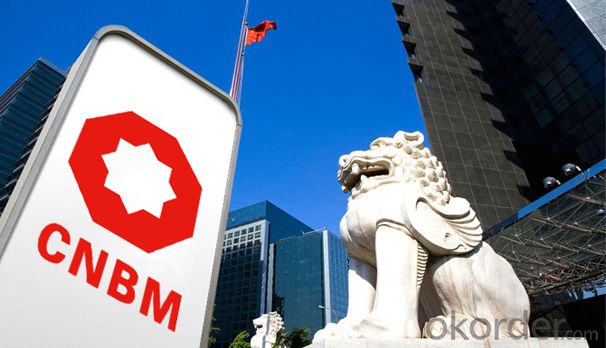
- Q: What is the impact resistance of fiberglass chopped strand?
- The impact resistance of fiberglass chopped strand is generally high, due to the inherent strength and durability of fiberglass material. It is known to withstand a wide range of impacts and provide resistance against cracking or breaking.
- Q: What is the difference between fiberglass and carbon fiber? ?
- It need for high strength, but also, and carbon fiber is only a single material, carbon fiber is conductive. In general, carbon fiber can be a raw material for glass fiber reinforced plastic. But the glass fiber reinforced plastic has now evolved into a general term. Not only the composite material made of resin and glass fiber is called glass fiber reinforced plastic. But the strength of the carbon fiber is much stronger than the glass fiber. Carbon fiber made for the composite material are often called glass fiber reinforced plastics.carbon fiber glass reinforced plastics used in anti-static condition are obviously different composite materials made of resin and glass fiber.
- Q: Is fiberglass chopped strand suitable for aerospace applications?
- Fiberglass chopped strand is generally not suitable for aerospace applications. While fiberglass is a versatile and cost-effective material widely used in various industries, including automotive and construction, its properties may not meet the stringent requirements of aerospace applications. Aerospace applications demand materials with exceptional strength-to-weight ratios, high temperature resistance, low thermal expansion, excellent fatigue resistance, and other specific characteristics. These requirements often necessitate the use of advanced composite materials such as carbon fiber or aramid fiber reinforced polymers. Although fiberglass chopped strand exhibits good tensile strength and corrosion resistance, it falls short in other critical areas. Its relatively high density and limited thermal stability make it less suitable for aerospace applications, where lightweight materials that can withstand extreme temperatures and harsh environments are essential. Moreover, aerospace components often require precise engineering and tight tolerances, which may be challenging to achieve with fiberglass chopped strand due to its limited dimensional stability and potential for delamination. Therefore, while fiberglass chopped strand may find numerous applications in various industries, it is typically not the material of choice for aerospace applications. Aerospace engineers and manufacturers prefer advanced composite materials with superior performance characteristics to ensure the safety, reliability, and efficiency of aerospace systems.
- Q: Is fiberglass chopped strand compatible with different resin systems?
- Different resin systems can be used with fiberglass chopped strand, including polyester, epoxy, vinylester, and polyurethane. The compatibility between the fiberglass chopped strand and the resin system is of utmost importance in order to achieve the best mechanical properties and overall performance of the composite material. It is essential to carefully select the resin system to ensure proper wetting and bonding of the chopped strands, which directly impacts the strength, stiffness, and other properties of the final composite product. To ensure compatibility and optimal performance, manufacturers often offer guidelines and recommendations for the preferred resin systems to be used with their specific fiberglass chopped strand products.
- Q: What are the typical fire safety regulations for fiberglass chopped strand composites?
- The typical fire safety regulations for fiberglass chopped strand composites vary depending on the specific application and industry standards. However, there are several general principles and regulations that are commonly followed to ensure fire safety in these composites. Firstly, it is important to understand that fiberglass chopped strand composites are inherently fire-resistant due to the non-combustible nature of the glass fibers. However, the surrounding matrix material used to bind the fibers together and provide structural properties may vary in terms of fire resistance. One common regulation is to use fire-retardant matrix materials in the manufacturing process of fiberglass chopped strand composites. These fire-retardant resins or polymers are specifically designed to reduce the flammability and slow down the spread of fire. They often contain additives or fillers that inhibit combustion and release fewer toxic fumes when exposed to fire. Additionally, the fire safety regulations may require specific testing and certification standards for fiberglass chopped strand composites. These tests typically evaluate the material's reaction to fire, such as flame spread, smoke generation, and heat release. The most commonly used fire tests for composites are the ASTM E84 (Surface Burning Characteristics) and UL94 (Flammability of Plastic Materials) tests. Furthermore, the regulations may also address the installation, handling, and storage of fiberglass chopped strand composites to minimize fire risks. This may include guidelines for proper ventilation, storage of flammable materials away from composites, and the use of fire-resistant barriers or coatings in specific applications. It is crucial for manufacturers, designers, and end-users of fiberglass chopped strand composites to consult the relevant industry standards, codes, and regulations specific to their application. Compliance with these regulations ensures the safe use and minimizes the fire hazards associated with these materials.
- Q: Can fiberglass chopped strand be used in the production of electrical insulators?
- Fiberglass chopped strand is indeed applicable in the manufacturing of electrical insulators. This versatile material boasts exceptional electrical insulation properties. With its high dielectric strength, it effectively opposes the flow of electrical current and prevents any leakage. Furthermore, fiberglass exhibits resistance against moisture and chemicals, rendering it suitable for a wide range of electrical applications. In the production of electrical insulators, fiberglass chopped strand is typically combined with a resin matrix to form a composite material that provides insulation and mechanical strength. This composite can be molded into various shapes and sizes to cater to the specific requirements of electrical insulators utilized in diverse applications. All in all, fiberglass chopped strand proves to be a dependable and cost-efficient option for the production of electrical insulators.
- Q: Is fiberglass chopped strand suitable for renewable energy applications?
- Yes, fiberglass chopped strand is suitable for renewable energy applications. Fiberglass is a versatile material known for its strength, durability, and resistance to corrosion, making it an ideal choice for various renewable energy applications. In wind energy, fiberglass chopped strand is commonly used in the manufacturing of wind turbine blades. The material's high tensile strength and ability to withstand harsh weather conditions make it an excellent choice for this application. Fiberglass also offers lightweight properties, which is crucial for minimizing the weight of the blades and maximizing energy production. Furthermore, fiberglass chopped strand is used in the construction of solar panels. The material provides excellent electrical insulation, which is essential for maintaining the efficiency and safety of solar panels. Fiberglass also offers high thermal resistance, enabling the panels to withstand extreme temperatures and prolong their lifespan. Additionally, fiberglass chopped strand can be used in the manufacturing of hydroelectric power equipment. Its corrosion resistance properties make it suitable for withstanding the harsh conditions present in hydroelectric power plants, such as exposure to water and moisture. Overall, fiberglass chopped strand is a reliable and effective material for renewable energy applications. Its strength, durability, and resistance properties make it a suitable choice for wind energy, solar power, and hydroelectric power applications.
- Q: How does the fiber volume fraction affect the properties of fiberglass chopped strand?
- The fiber volume fraction refers to the ratio of the volume of fibers to the total volume of the composite material. In the case of fiberglass chopped strand, increasing the fiber volume fraction typically leads to improvements in several properties. One of the main benefits of increasing the fiber volume fraction is the enhancement in the mechanical strength of the material. Fiberglass chopped strand consists of short fibers randomly dispersed within a matrix material, such as epoxy resin. When the fiber volume fraction is increased, the number of fibers per unit volume also increases, resulting in an increased load-bearing capacity. This leads to improved tensile, compressive, and flexural strength of the composite material. Furthermore, increasing the fiber volume fraction also enhances the stiffness and rigidity of the fiberglass chopped strand composite. The fibers act as reinforcements, effectively transferring stress and strain throughout the material. This results in reduced deformation and improved dimensional stability under load. The increased fiber volume fraction also contributes to the improved resistance to bending and buckling, making the material more suitable for applications that require high structural integrity. Additionally, the fiber volume fraction affects the impact resistance and fatigue life of the fiberglass chopped strand composite. The presence of a higher volume of fibers increases the energy absorption capability, making the material more resistant to impact and reducing the risk of cracking or fracture. This is particularly important in applications where the composite is subjected to dynamic loading or repetitive stress. However, it is worth noting that there is an upper limit to the fiber volume fraction beyond which the properties of the fiberglass chopped strand composite may not continue to improve. At very high fiber volume fractions, issues such as fiber entanglement, poor resin impregnation, and increased processing difficulty may arise. Therefore, finding the optimal fiber volume fraction is crucial to achieve the desired balance between mechanical properties and processability. In conclusion, increasing the fiber volume fraction in fiberglass chopped strand has a positive impact on the material's mechanical strength, stiffness, impact resistance, and fatigue life. The optimal fiber volume fraction depends on the specific application requirements and the processing limitations, and finding the right balance is important to achieve the desired performance.
- Q: What is the thermal shock resistance of fiberglass chopped strand?
- The thermal shock resistance of fiberglass chopped strand is generally high, as it can withstand rapid changes in temperature without cracking or breaking.
- Q: What is the cost of fiberglass chopped strand compared to other materials?
- The price of fiberglass chopped strand can vary based on factors such as quality, quantity, and supplier. However, generally speaking, fiberglass chopped strand is considered a cost-effective material compared to other options. When compared to materials like carbon fiber or aramid, fiberglass chopped strand is typically more affordable. This is because the production process of fiberglass is simpler and less expensive. Additionally, fiberglass chopped strand is readily available and has a significant market share, which helps keep prices competitive. In contrast to traditional materials like steel or aluminum, fiberglass chopped strand can also provide cost advantages. Fiberglass is generally lighter in weight, which can lower transportation and installation costs. It is also resistant to corrosion, eliminating the need for additional coatings or treatments to prevent rust or deterioration. Moreover, fiberglass chopped strand offers excellent strength-to-weight ratios, making it a cost-effective option for applications requiring high strength and durability. It is important to note that while fiberglass chopped strand may have a lower initial cost compared to some materials, the overall cost-effectiveness depends on the specific application, performance requirements, and long-term maintenance considerations. Conducting a comprehensive cost analysis and considering factors beyond the initial purchase price is crucial in determining the true cost of using fiberglass chopped strand compared to other materials.
Send your message to us
Fiberglass Chopped Strand Mat Combination Mat Slide Mat
- Loading Port:
- China main port
- Payment Terms:
- TT OR LC
- Min Order Qty:
- 1 kg
- Supply Capability:
- 5000 kg/month
OKorder Service Pledge
OKorder Financial Service
Similar products
Hot products
Hot Searches
Related keywords

